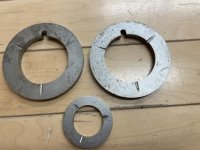TheBigLebowski
Aluminum
- Joined
- Sep 9, 2018
The washers ready to go to heat treat. I made an extra large one as a practice piece. Ground with the same 46H wheel I used on my chuck. I will be getting the recommended Norton 5SG-46H for grinding the hardened washers.
View attachment 344128
bll230, I tried to respond to your pm but your inbox is full, Response below.
Sorry for the delayed response, I hope you were able to grind those parts without too much trouble.
Plunge grinding is done with no crossfeed motion, only table and downfeed are used. Each time you pass the wheel over the part, you feed down slightly so wheel continues to grind away at the part. You do this until you've reached the depth you want. This will leave you with a slot the same width as the wheel that is near finished depth.
Next you would raise the wheel up to clear the part, feed over slightly less then the width of the wheel and repeat to cut away another slot, continue repeating that process until the entire surface is lowered.
It works great for roughing small parts where the wheel isn't in contact with the part for very long, though it would be ill advised to use on longer parts.
As for manual grinding (in my opinion) is capable of taking deeper cuts, its simply because you have more control and feedback on what the grinder is doing. You can almost instantly feel when a cut isn't quite right on a manual grinder and correct course.
On the flip side, it's not necessary to grind aggressively using an auto grinder with coolant, as you can simply walk away with it and let it do its thing.


